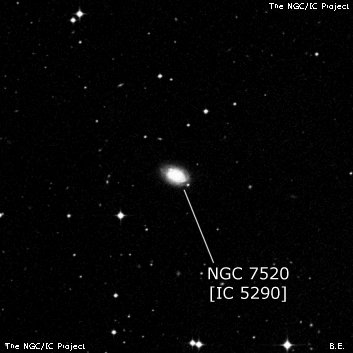
NGC 7520 is listed as nonexistent in most sources. Harold Corwin suggests the possibility that NGC 7520 is equivalent to IC 5290 (described above).
Wilhelm Tempel discovered NGC 7520 = T I-49 in 1876 and noted "class II size; class III brightness; seen repeatedly; position difficult to determine." There is nothing near his rough position (given only to the nearest min of time and noted as very uncertain "::"). Herbert Howe was unsuccessful in locating it on two nights at the Chamberlin Observatory in Denver and RNGC classifies the number as nonexistent.
Harold Corwin suggests that NGC 7520 may be identical to IC 5290, discovered by Johann Palisa on 4 Oct 1896 with the 27-inch refractor at Vienna (1897AN....143...49W). This requires Tempel's declination to be 20' too far south, though the RA is less than a minute off.
400/500mm - 18" (10/25/08): fairly faint, fairly small, elongated 3:2 SW-NE, 0.6'x0.4', very weak concentration. Situated between two fainter doubles 5' NNE (a 15" pair of mag 13.5/14.5 stars) and 5' S (a 10" pair of mag 14 stars). Another mag 13 star lies 2' SE.
Notes by Steve Gottlieb